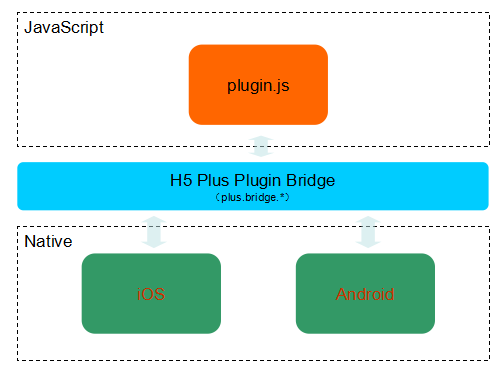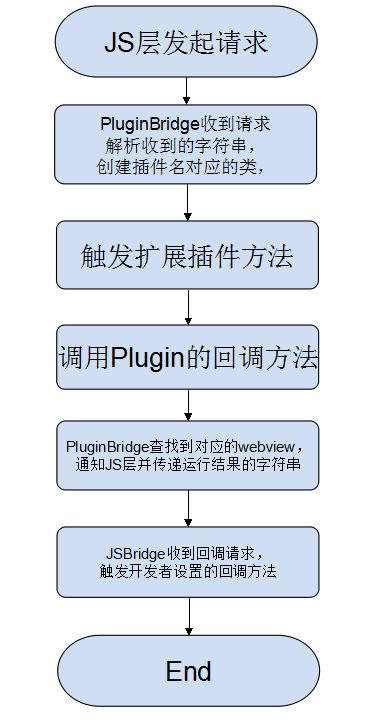5+原生插件将不再继续维护,建议开发者升级应用为uni-app项目并使用uni原生插件。uni原生插件文档本文为5+app插件开发指南。uni-app请另外参考文档:https://ask.dcloud.net.cn/article/35428
欢迎有原生开发能力的朋友入群一起交流学习(入群请提供注册邮箱):
DCloud原生开发者群:
1群:256775471
2群:814228233
3群:455763866
技术架构
HTML5+ 基座扩展采用三层结构,JS层、PluginBridge层和Native层。 三层功能分别是:
JS层: 在Webview页面调用,触发Native层代码,获取执行结果。
PluginBridge层: 将JS层请求进行处理,触发Native层扩展插件代码。
Native层: 插件扩展的平台原生代码,负责执行业务逻辑并执行结果返回到请求页面。

开发者在开发扩展插件时需要为扩展插件编写对应的JS API,JS API将在HTML页面中触发调用对应Native扩展方法的请求,并负责接收运行结果。
开发者在编写扩展插件的JS时需要调用Javascript Plugin Bridge的API用来完成对Native层代码的调用和运行结果的返回。在实际应用中,开发者可以根据扩展方法的实际需求不同,将插件的扩展方法设置为同步执行或异步执行。
同步执行的扩展方法会阻塞当前JS代码的执行,直到Native层插件扩展方法执行完毕。异步扩展方法不会阻塞当前JS代码的执行,使用者需要设置回调方法接收Native层返回的执行结果,开发者需要在插件中调用 Native plugin brigde的方法将执行结果返回到请求页面。
工程示例请参考SDK内包含的HBuilder-Integrate工程,工程里已经整合了插件开发和集成方式的示例。
扩展插件工作流程
异步方法的执行不会阻塞当前JS的运行,方法的执行结果会通过回调的方式返回。
插件异步扩展方法:
同步方法的执行会阻塞当前JS的运行,方法执行完成后可直接获取执行的结果。
插件同步扩展方法:
扩展插件JS API 编写
开发者在实现JS层API时首先要定义一个插件类的别名,并需要在Android工程的assets\data\properties.xml文件中声明插件类别名和Native层扩展插件类的对应关系
<properties>
<features>
<feature name="plugintest" value="com.example.H5PlusPlugin.PGPlugintest"></feature>
</properties>示例中为方便查看删除了其他插件的代码,开发者在可根据5+应用使用插件的情况进行增删修改。
Feature节点下声明的插件将会在调用时创建相应的对象。
JS扩展方法的实现
同步返回JS扩展方法实现
在实现同步扩展方法时,开发者需要调用JS Plugin Bridge的window.plus.bridge.execSync()
方法,该方法可同步获取Native插件返回的运行结果。
void plus.bridge.execSync( String service, String action, Array<String> args );service: 插件类别名
action: 调用Native层插件方法名称。
args: 参数列表。
异步返回JS扩展方法实现
在实现异步扩展方法时,开发者需要调用JS Plugin Bridge的plus.bridge.exec()方法,该方法会通知Native层插件执行指定方法,运行结果会通过回调的方式通知JS层
void plus.bridge.exec( String service, String action, Array<String> args );service: 插件类别名
action: 调用Native层插件方法名称。
args: 参数列表。
扩展插件JS API代码示例:
! function(root, factory) {
if (typeof exports == 'object' && typeof module != 'undefined') {
module.exports = factory()
} else if (typeof define == 'function' && define.amd) {
define(factory)
} else {
/**
* 插件对象直接扩展到 window 对象上
* 这个对象的名字,需要自己填写一下。例如:plugintest
*/
var moduleName = 'plugintest';
root[moduleName] = factory()
}
}(this, function() {
var _BARCODE = 'plugintest';
var plugintest = {
PluginTestFunction: function(Argus1, Argus2, Argus3, Argus4, successCallback, errorCallback) {
var success = typeof successCallback !== 'function' ? null : function(args) {
successCallback(args);
},
fail = typeof errorCallback !== 'function' ? null : function(code) {
errorCallback(code);
};
callbackID = plus.bridge.callbackId(success, fail);
return plus.bridge.exec(_BARCODE, "PluginTestFunction", [callbackID, Argus1, Argus2, Argus3, Argus4]);
},
PluginTestFunctionArrayArgu: function(Argus, successCallback, errorCallback) {
var success = typeof successCallback !== 'function' ? null : function(args) {
successCallback(args);
},
fail = typeof errorCallback !== 'function' ? null : function(code) {
errorCallback(code);
};
callbackID = plus.bridge.callbackId(success, fail);
return plus.bridge.exec(_BARCODE, "PluginTestFunctionArrayArgu", [callbackID, Argus]);
},
PluginTestFunctionSync: function(Argus1, Argus2, Argus3, Argus4) {
return plus.bridge.execSync(_BARCODE, "PluginTestFunctionSync", [Argus1, Argus2, Argus3, Argus4]);
},
PluginTestFunctionSyncArrayArgu: function(Argus) {
return plus.bridge.execSync(_BARCODE, "PluginTestFunctionSyncArrayArgu", [Argus]);
}
};
return plugintest;
});Html使用示例
<!DOCTYPE HTML>
<html>
<head>
<meta charset="utf-8"/>
<meta name="viewport" content="initial-scale=1.0, maximum-scale=1.0, user-scalable=no"/>
<meta name="HandheldFriendly" content="true"/>
<meta name="MobileOptimized" content="320"/>
<title>H5Plugin</title>
<script type="text/javascript" src="./js/common.js"></script>
<script type="text/javascript" src="./js/test.js"></script>
<script type="text/javascript">
function pluginShow() {
plus.plugintest.PluginTestFunction("Html5","Plus","AsyncFunction","MultiArgument!", function( result ) {alert( result[0] + "_" + result[1] + "_" + result[2] + "_" + result[3] );},function(result){alert(result)});
}
function pluginShowArrayArgu() {
plus.plugintest.PluginTestFunctionArrayArgu( ["Html5","Plus","AsyncFunction","ArrayArgument!"], function( result ) {alert( result );},function(result){alert(result)});
}
function pluginGetString()
{
alert(plus.plugintest.PluginTestFunctionSync("Html5","Plus","SyncFunction","MultiArgument!"));
}
function pluginGetStringArrayArgu()
{
var Argus = plus.plugintest.PluginTestFunctionSyncArrayArgu(["Html5","Plus","SyncFunction","ArrayArgument!"]);
alert( Argus.RetArgu1 + "_" + Argus.RetArgu2 + "_" + Argus.RetArgu3 + "_" + Argus.RetArgu4 );
}
</script>
<link rel="stylesheet" href="./css/common.css" type="text/css" charset="utf-8"/>
</head>
<body>
<header>
<div class="nvbt" onclick="back();"><div class="iback"></div></div>
<div class="nvtt">PluginTest</div>
</header>
<div id="dcontent" class="dcontent">
<br/>
<div class="button" onclick="pluginShow()">PluginTestFunction()</div>
<div class="button" onclick="pluginShowArrayArgu()">PluginTestFunctionArrayArgu()</div>
<div class="button" onclick="pluginGetString()">PluginTestFunctionSync()</div>
<div class="button" onclick="pluginGetStringArrayArgu()">PluginTestFunctionSyncArrayArgu()</div>
<br/>
</div>
</body>
</html>uni-app 使用示例
uni-app 中无需主动监听 plusready,可以直接调用 plus 相关的 API。
<template>
<view>
<button @click="pluginShow">pluginShow</button>
</view>
</template>
<script>
// 扩展的 js 文件的位置:common/plugins.js
var plugins = require('../../common/plugins.js')
export default {
data() {
return {
plugins: plugins
};
},
methods: {
pluginShow() {
this.plugins.PluginTestFunction("Html5", "Plus", "AsyncFunction", "MultiArgument!", function(result) {
console.log(result[0] + "_" + result[1] + "_" + result[2] + "_" + result[3]);
}, function(result) {
console.log(result)
});
}
}
}
</script>
<style>
</style>Android第三方插件开发指导
准备
首先要下载HTML5+基座的Android版SDK点击下载解压后将HBuilder-Integrate工程导入到ADT中。
uni-app插件开发
老接口实现方式
开发步骤
创建插件类
开发者创建的扩展插件类应当继承自“IFeature”类实现第三方插件扩展。
创建插件类需要引入的包
import io.dcloud.common.DHInterface.AbsMgr;
import io.dcloud.common.DHInterface.IFeature;
import io.dcloud.common.DHInterface.IWebview;
import io.dcloud.common.util.JSUtil;实现接口类的“excute”方法
excute方法负责接收由html页面发起的扩展插件调用请求,并负责根据传入参数运行执行对应的业务。
“execute”方法的“action”参数传入的是JS类的方法名,类型为String。开发者需要在方法中通过字符串匹配来处理请求的逻辑。“pArgs”参数为字符串列表对象,如JS层调用的方法有传入参数,会通过该参数传递到Native的方法中,方法的传入顺序和JS层传入顺序一致。
开发者在实现同步和异步接口运行结果返回时调用的API是不同的
同步执行方法:
同步执行方法在返回结果时可以直接将结果以return的形式返回给js层,返回的结果需要调用
JSUtil.wrapJsVar("Html5 Plus Plugin Hello1!",true);处理要返回的字符串,也可调用其他方法处理其他返回值类型(参考io.dclod.util.JSUtil的返回方法)。
异步执行方法:
异步方法开发者需要调用
JSUtil.execCallback(pWebview, cbId, (which==AlertDialog.BUTTON_POSITIVE)?"ok":"cancel", JSUtil.OK, false, false); 代码实例
package com.example.H5PlusPlugin;
import io.dcloud.common.DHInterface.AbsMgr;
import io.dcloud.common.DHInterface.IFeature;
import io.dcloud.common.DHInterface.IWebview;
import io.dcloud.common.util.JSUtil;
import org.json.JSONArray;
import org.json.JSONException;
import org.json.JSONObject;
import android.annotation.SuppressLint;
import android.annotation.TargetApi;
import android.os.Build;
public class PGPlugintest implements IFeature
{
@Override
public void init(AbsMgr arg0, String arg1) {
// TODO Auto-generated method stub
}
@SuppressWarnings("deprecation")
@TargetApi(Build.VERSION_CODES.CUPCAKE)
@SuppressLint("NewApi")
@Override
public String execute(final IWebview pWebview, final String action, final String[] pArgs) {
// TODO Auto-generated method stub
//Context context = pWebview.getContext();
if ("PluginTestFunction".equals(action))
{
String CallBackID = pArgs[0];
JSONArray newArray = new JSONArray();
newArray.put(pArgs[1]);
newArray.put(pArgs[2]);
newArray.put(pArgs[3]);
newArray.put(pArgs[4]);
JSUtil.execCallback(pWebview, CallBackID, newArray, JSUtil.OK, false);
}
else if("PluginTestFunctionArrayArgu".equals(action))
{
String ReturnString = null;
String CallBackID = pArgs[0];
JSONArray newArray = null;
try {
newArray = new JSONArray(pArgs[1]);
String inValue1 = newArray.getString(0);
String inValue2 = newArray.getString(1);
String inValue3 = newArray.getString(2);
String inValue4 = newArray.getString(3);
ReturnString = inValue1 + "-" + inValue2 + "-" + inValue3 + "-" + inValue4;
} catch (JSONException e) {
// TODO Auto-generated catch block
e.printStackTrace();
}
JSUtil.execCallback(pWebview, CallBackID, ReturnString, JSUtil.OK, false);
}else if("PluginTestFunctionSync".equals(action))
{
String inValue1 = pArgs[0];
String inValue2 = pArgs[1];
String inValue3 = pArgs[2];
String inValue4 = pArgs[3];
String ReturnValue = inValue1 + "-" + inValue2 + "-" + inValue3 + "-" + inValue4;
return JSUtil.wrapJsVar(ReturnValue,true);
}else if("PluginTestFunctionSyncArrayArgu".equals(action))
{
JSONArray newArray = null;
JSONObject retJSONObj = null;
try {
newArray = new JSONArray(pArgs[0]);
String inValue1 = newArray.getString(0);
String inValue2 = newArray.getString(1);
String inValue3 = newArray.getString(2);
String inValue4 = newArray.getString(3);
retJSONObj = new JSONObject();
retJSONObj.putOpt("RetArgu1", inValue1);
retJSONObj.putOpt("RetArgu2", inValue2);
retJSONObj.putOpt("RetArgu3", inValue3);
retJSONObj.putOpt("RetArgu4", inValue4);
} catch (JSONException e1) {
// TODO Auto-generated catch block
e1.printStackTrace();
}
return JSUtil.wrapJsVar(retJSONObj);
}
return null;
}
@Override
public void dispose(String arg0) {
// TODO Auto-generated method stub
}
}新接口实现方式
创建插件类
创建一个继承自StandardFeature的类,实现第三方插件扩展。
创建插件类需要引入的包
import io.dcloud.DHInterface.IWebview;
import io.dcloud.DHInterface.StandardFeature;
import io.dcloud.util.JSUtil;
实现扩展方法
Native层扩展插件的方法名需要和JS Plugin Bridge里windows.plus.bridge.exec()或windows.plus.bridge.execSync()方法的第二个传入参数相同,否则无法调用到指定的方法。
public void PluginTestFunction(IWebview pWebview, JSONArray array)扩展方法有两个传入参数
IWebview pWebview 发起请求的webview,
JSONArray array JS请求传入的参数
开发者在实现同步和异步接口运行结果返回时调用的API是不同的
同步执行方法:
同步执行方法在返回结果时可以直接将结果以return的形式返回给js层,返回的结果需要调用
JSUtil.wrapJsVar("Html5 Plus Plugin Hello1!",true);处理要返回的字符串,也可调用其他方法处理其他返回值类型(参考io.dclod.util.JSUtil的返回方法)。
异步执行方法:
异步方法开发者需要调用
JSUtil.execCallback(pWebview, cbId, (which==AlertDialog.BUTTON_POSITIVE)?"ok":"cancel", JSUtil.OK, false, false); 代码示例
package com.example.H5PlusPlugin;
import io.dcloud.common.DHInterface.IWebview;
import io.dcloud.common.DHInterface.StandardFeature;
import io.dcloud.common.util.JSUtil;
import org.json.JSONArray;
import org.json.JSONException;
import org.json.JSONObject;
public class PGPlugintest extends StandardFeature
{
public void PluginTestFunction(IWebview pWebview, JSONArray array)
{
String CallBackID = array.optString(0);
JSONArray newArray = new JSONArray();
newArray.put(array.optString(1));
newArray.put(array.optString(2));
newArray.put(array.optString(3));
newArray.put(array.optString(4));
JSUtil.execCallback(pWebview, CallBackID, newArray, JSUtil.OK, false);
}
public void PluginTestFunctionArrayArgu(IWebview pWebview, JSONArray array)
{
String ReturnString = null;
String CallBackID = array.optString(0);
JSONArray newArray = null;
try {
newArray = new JSONArray( array.optString(1));
String inValue1 = newArray.getString(0);
String inValue2 = newArray.getString(1);
String inValue3 = newArray.getString(2);
String inValue4 = newArray.getString(3);
ReturnString = inValue1 + "-" + inValue2 + "-" + inValue3 + "-" + inValue4;
} catch (JSONException e) {
// TODO Auto-generated catch block
e.printStackTrace();
}
JSUtil.execCallback(pWebview, CallBackID, ReturnString, JSUtil.OK, false);
}
public String PluginTestFunctionSyncArrayArgu(IWebview pWebview, JSONArray array)
{
JSONArray newArray = null;
JSONObject retJSONObj = null;
try {
newArray = array.optJSONArray(0);
String inValue1 = newArray.getString(0);
String inValue2 = newArray.getString(1);
String inValue3 = newArray.getString(2);
String inValue4 = newArray.getString(3);
retJSONObj = new JSONObject();
retJSONObj.putOpt("RetArgu1", inValue1);
retJSONObj.putOpt("RetArgu2", inValue2);
retJSONObj.putOpt("RetArgu3", inValue3);
retJSONObj.putOpt("RetArgu4", inValue4);
} catch (JSONException e1) {
// TODO Auto-generated catch block
e1.printStackTrace();
}
return JSUtil.wrapJsVar(retJSONObj);
}
public String PluginTestFunctionSync(IWebview pWebview, JSONArray array)
{
String inValue1 = array.optString(0);
String inValue2 = array.optString(1);
String inValue3 = array.optString(2);
String inValue4 = array.optString(3);
String ReturnValue = inValue1 + "-" + inValue2 + "-" + inValue3 + "-" + inValue4;
return JSUtil.wrapJsVar(ReturnValue,true);
}
}
三 关联JS插件名和原生类
在编写扩展插件时需要修改“/assets/data”中properties.xml文件,在其中添加JS对象名称和Android包的类名对应关系,SDK会根据对应的类名查找并生成相应的对象并执行对应的逻辑。
在应用的manifest.json文件中还需要添加扩展插件的应用使用权限
Android平台插件开发API
io.dcloud.DHInterface.IFeature
扩展插件接口类,Android平台的扩展插件应当继承自此接口类并实现接口方法。
常用方法说明:
String execute(IWebview pWebView, String action, String[] pArgs);执行扩展插件的方法,调用native代码实现具体的操作。
pWebView: 扩展插件方法运行的窗口
action: 调用插件方法的名称
args: 调用插件方法使用的参数列表
io.dcloud.util.JSUtil
常用方法说明:
String wrapJsVar(String value, boolean isString);转换JS层的返回值,也用于异步接口中回调函数的参数。
参数说明:
value: 要返回到JS层的值
isString:返回值类型是否为原始字符串
返回方法:
boolea类型: wrapJSVar( "true", false );
Number类型: wrapJsVar( "99", false );
String类型: wrapJsVar( "hello", true );
数组类型: wrapJsVar( "[1,2,3,4,5]", false );
JSON类型: wrapJsVar( "{'name':'value'}", false );
String execCallback(IWebview pWebView, String pCallbackId, String pMessage, int pStatus, boolean isJson, boolean pKeepCallback);触发扩展插件中的回调方法。
参数说明:
pWebView:扩展插件方法运行的窗口
pCallbackId:回调函数的唯一标识
pMessage:回调函数的参数
pStatus:操作是否成功,成功则使用JSUtil.OK,否则使用错误代码
isJson:回调函数参数是否为JSON数据
pKeepCallback:是否可多次触发回调函数
术语字典
JS Plugin Bridge: H5+ Plugin Bridge层JS部分API,用户通过调用相应的API触发Native层扩展插件相应方法的调用。
Native Plugin Bridge: H5+ Plugin Bridge层Native部分API,开发者通过实现接口类方法,实现由JS层触发Native层扩展插件逻辑。开发者调用API实现Native扩展方法运行结果得返回。
Native层插件:开发者使用原生语言实现的5+扩展插件,可被JS层通知调用。
插件类别名:JS层字符串,用来声明JS方法和Native层插件的对应关系







